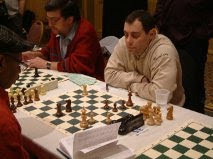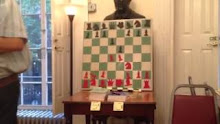Now I avoided 9.O-O because of 9...a6 10.f4 Nxd4 11.Bxd4 b5 as in Fischer-Spassky, Reykjavik 1972 which continued 12.a3 Bb7 13.Qd3 a5 14.e5 dxe5 15.fxe5 Nd7 16.Nxb5 Nc5 17.Bxc5 Bxc5+ 18.Kh1 Qg5 19.Qe2 Rad8 20.Rad1 Rxd1 21.Rxd1 h5 with a strong attack for Black; or 12.e5 dxe5 13.fxe5 Nd7 14.Ne4 Bb7 15.Nd6 Bxd6 16.exd6 Qg5 17.Qe2 e5 18.Bc3 Qg6 19.Rad1 Kh8 20.Bd5 Bxd5 21.Rxd5 Qe6 22.Rfd1 Rfc8 23.Ba5 Rc6 24.b3 Rac8 25.Bc7 as in Short-Kasparov, London 1993 when Kasparov's suggestion of 25...f5 planning ...e4 equalizes.
Instead my game continued 9.f4 Qa5?! (better 9...Nxd4 10.Bxd4 e5!) 10.O-O Re8?! 11.Qf3 Bd7 12.f5 Nxd4 13.Bxd4 e5 14.Bf2 Bc6 15.Bh4!? (better 15.g4) Nxe4 16.Nxe4 Bxh4 17.Qh5 d5 18.Qxh4 dxe4 19.f6 g6 20.Rad1.
The tempting 20.Bxf7+!? Kxf7 21.Qxh7+ Ke6 22.Qxg6 Qc5+ 23.Kh1 Rf8 24.Qg4+ Kd6 allows the black king to escape. Following 20.Rad1, I felt that I had good compensation for the pawn due to Black's weakened kingside.
The game concluded 20...Qc5+ 21.Kh1 Qf8 22.Qg5 Rac8 23.h4 Kh8 24.h5 h6 25.Qe3 g5 26.Qxa7 Red8 27.Qa5 Rxd1 28.Rxd1 Qe8 29.Qd2 Kg8 30.c3 Qf8 31.Bc2 Qc5 32.Qe2 Qb6 33.Bb3 Rd8 34.Rf1 e3 35.Qg4 Qc5 36.Qf5 Rd2?? 37.Qg6+, 1-0.
My opponent was in severe time trouble near the end of the game.
In March 2001, at the Marshall Chess Club, I beat Roman Dubinsky [USCF 2364] in a game/30 contest that featured 6.Bc4 versus his Najdorf variation. The opening moves were 1.e5 c5 2.Nf3 d6 3.d4 Nf6 4.Nc3 cxd4 5.Nxd4 a6 6.Bc4 e6 7.Bb3 b5 8.O-O Be7 9.Be3 O-O 10.f4 b4 [10...Bb7 11.e5 dxe5 12.fxe5 Nd5 13.Nxd5 Bxd5 14.Bxd5 Qxd5 15.Nf5! with clear advantage for White, IM Mike Valvo - NM Jim West, New Jersey Masters Invitational 1986; or 10...Qc7 11.a3 Bb7 12.f5 e5 13.Nde2 Nbd7 14.Ng3 Bc6 15.Bg5 Rac8 16.Nh5 Rfe8 17.Bxf6 Nxf6 18.Bd5 Bxd5 19.Nxf6+ Bxf6 20.Qxd5 Qc5+ 21.Qxc5 Rxc5 22.Rad1 Be7 23.Rf2 Rec8 24.Nd5 Kf8 25.c3 R8c6 26.Re2 a5 27.b4 Rc4 28.a4 axb4 29.axb5 R6c5 30.cxb4 Rxb5 31.Ra1 Rb8 32.Ra7 Bd8 33.Ra6 Be7 34.Kf2 Bg5 35.b5 Rc5 36.b6 (36.Rb2!) Rb5 37.Rea2 Bd8 38.b7 R5xb7 39.Rxd6 Bb6+ 40.Nxb6 Rxb6 41.Rxb6 Rxb6 42.Ra5 f6 43.Ra8+ Kf7 44.Ra7+ Kf8 45.Ra8+, draw, Jim West (USCF 2277) - Orest Popovych (USCF 2281), New York Open 1997] 11.Na4 Bb7.
According to book theory, Black already stands better here. But in the late 1980's, international master Mike Valvo published an article in Atlantic Chess News that overturned the conventional wisdom on this position. The next few moves in the game followed Valvo's analysis: 12.e5 dxe5 13.Nxe6!? fxe6 14.Bxe6+ Kh8 15.Qxd8! [Mike Valvo-Orest Popovych, New Jersey International 1987] Rxd8 16.fxe5 Ne4 17.Nb6 Ra7 18.Na4 Ra8 19.Nb6.
Now my higher rated opponent was understandably reluctant to accept the draw by repetition, but the correct way to do so would have been 19...Ra7 (19...Nc6 20.Bd5!) 20.Na4 Nc6!? 21.Bxa7 Nxa7 with chances for both sides.
Instead he blundered with 19...Nc5? 20.Rf7! Nc6 21.Rxe7 Ra7? 22.Bxc5 Nxe7 23.Bxe7 Re8 24.Rd1! Bc6 25.Nc8 Ra8 26.Rd8 Rxd8 27.Bxd8 h6 28.Nd6 Kh7 29.Ba5 Rb8 30.c3 bxc3 31.Bxc3 and White's e-pawn carried the day.
Instead of 12...dxe5, Valvo felt that Black's best try would be 12...Nd5 13.Bxd5 Bxd5 14.Nf5 Nd7 15.Nxd6 [15.exd6 Bf6 16.Nd4 Qb8 17.c3 bxc3 18.Nxc3 Qxd6 19.Nf5! exf5 20.Nxd5 Rfd8 21.Nxf6+ Nxf6 22.Qxd6 Rxd6 23.Rfd1 Rad8 24.Rxd6 Rxd6 25.Kf1 Ng4 26.Bg1 Rd2 27.b4 h5 28.a4 Rb2 29.b5 axb5 30.a5! Rc2 31.a6 Rc8 32.a7 Ra8 33.Ra5 b4 34.Rb5 Nxh2+ 35.Ke2 Re8+ 36.Kd3, 1-0, NM Jim West - NM Leroy Dubeck, Runnemede NJ 1997] Bxd6 16.exd6 Qb8 17.Qd2 (17.c3!?) Qxd6 18.c4, but that White would have good winning chances because of his queenside majority and slight initiative.
{This article originally appeared in the Spring 2001 issue of Empire Chess}




























